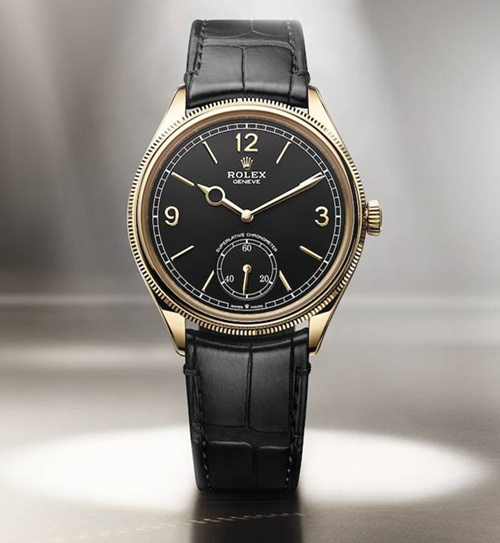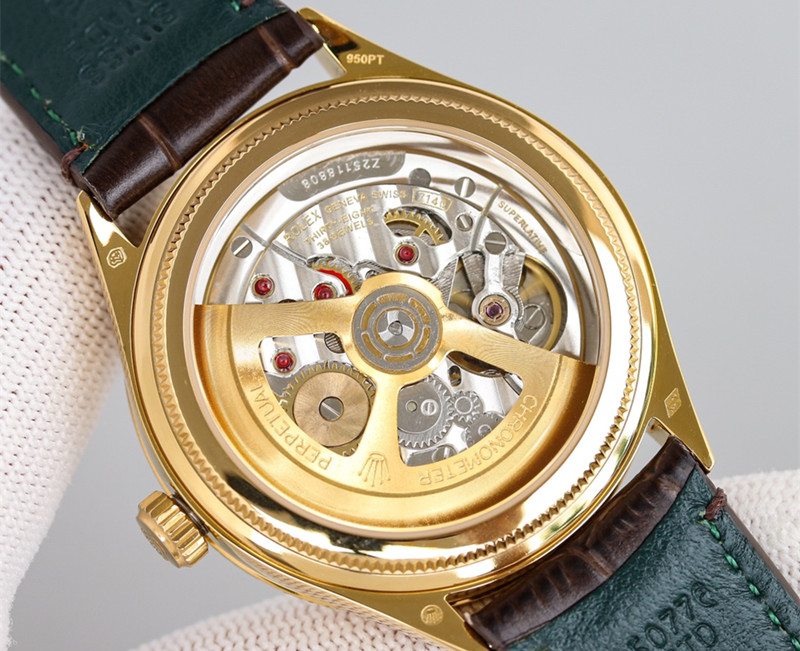Rolex unveiled the Oyster Perpetual 1908 series in 2023, signifying a momentous chapter for the brand. If you're a devoted Rolex enthusiast, you'd likely be aware that 1908 marks the year of the brand's inception. The founder, Hans Wilsdorf, officially registered the term "ROLEX" as a trademark in that year. By naming the new series after its founding year, Rolex aims to incorporate classic designs from that era and express the brand's commitment to its origins with high expectations for the new collection.
 Rumors suggest that the remarkable clone Rolex Perpetual 1908 is considered the successor to the Cellini series. From an aesthetic standpoint, both series follow a formal watch design, featuring precious metal cases paired with leather straps. Since the introduction of the Oyster Perpetual 1908, Rolex has discreetly removed the Cellini series from its official website, affirming its position as the "successor." The two series share not only similar product positioning but also identical parameters, such as a 39mm case diameter, making it a spiritual continuation of the Cellini series.
Rumors suggest that the remarkable clone Rolex Perpetual 1908 is considered the successor to the Cellini series. From an aesthetic standpoint, both series follow a formal watch design, featuring precious metal cases paired with leather straps. Since the introduction of the Oyster Perpetual 1908, Rolex has discreetly removed the Cellini series from its official website, affirming its position as the "successor." The two series share not only similar product positioning but also identical parameters, such as a 39mm case diameter, making it a spiritual continuation of the Cellini series.
The primary distinction lies in the dial design between the two series:
(1) The Oyster Perpetual 1908 adopts a small three-hand layout with Arabic numerals at 3, 9, and 12 o'clock. The hour hand features a hollow circular ring at the front, resembling an enlarged version of a "Breguet hand" or a "hollowed-out Mercedes hand," as some enthusiasts call it.
(2) Simultaneously, the Oyster Perpetual 1908 has a reduced crown volume compared to the Cellini, creating a more refined visual impression. Due to the non-screw-down crown design, the crown logo can be rotated to any angle according to preference, earning approval from some meticulous watch enthusiasts.
 The attention garnered by the new series is not only due to its exterior design but also because of the debut of the Cal.7140 automatic movement it houses. The significance of this movement goes beyond the timepiece itself. In contrast to previous replica Rolex watches with solid case backs, both the Oyster Perpetual 1908 and the new Cosmograph Daytona feature transparent case backs, showcasing the movement structure and operation to the wearer. Consequently, the Cal.7140 movement incorporates meticulous details in its aesthetics:
The attention garnered by the new series is not only due to its exterior design but also because of the debut of the Cal.7140 automatic movement it houses. The significance of this movement goes beyond the timepiece itself. In contrast to previous replica Rolex watches with solid case backs, both the Oyster Perpetual 1908 and the new Cosmograph Daytona feature transparent case backs, showcasing the movement structure and operation to the wearer. Consequently, the Cal.7140 movement incorporates meticulous details in its aesthetics:
(1) The movement bridge is adorned with a unique Geneva stripe, with polished grooves between each column.
(2) The engravings on the bridge are filled with gold, and the edges of jewel bearings are accentuated with gold sleeves. These details contribute to the high aesthetic value of the Cal.7140 movement.
(3) In terms of specifications, the Rolex 7140 automatic movement has a vibration frequency of 28,800 beats per hour (4 Hz), with a theoretical maximum power reserve of 66 hours.
(4) The larger significance of the Cal.7140 movement lies in its compact size: with a thickness of only 4.05mm (including the automatic rotor), it reduces approximately 34% compared to Cal.3230/Cal.3235, making it more suitable for slim watch cases.
Previously, the Cellini series featured a moon phase watch powered by the Cal.3195 automatic movement based on the 31-series architecture. Despite intentional thickness control by the brand, the overall thickness of the watch (sapphire crystal, case, and case back) made it challenging to describe as "slim." The Cal.7140 movement, with its mere 4.05mm thickness, even with additional complex function modules, manages to keep the overall thickness within a considerable range. This advantage was not present in previous Rolex movements. Therefore, it is not ruled out that the brand may expand the use of the Cal.7140 movement in the future or introduce more complicated models based on this movement.



